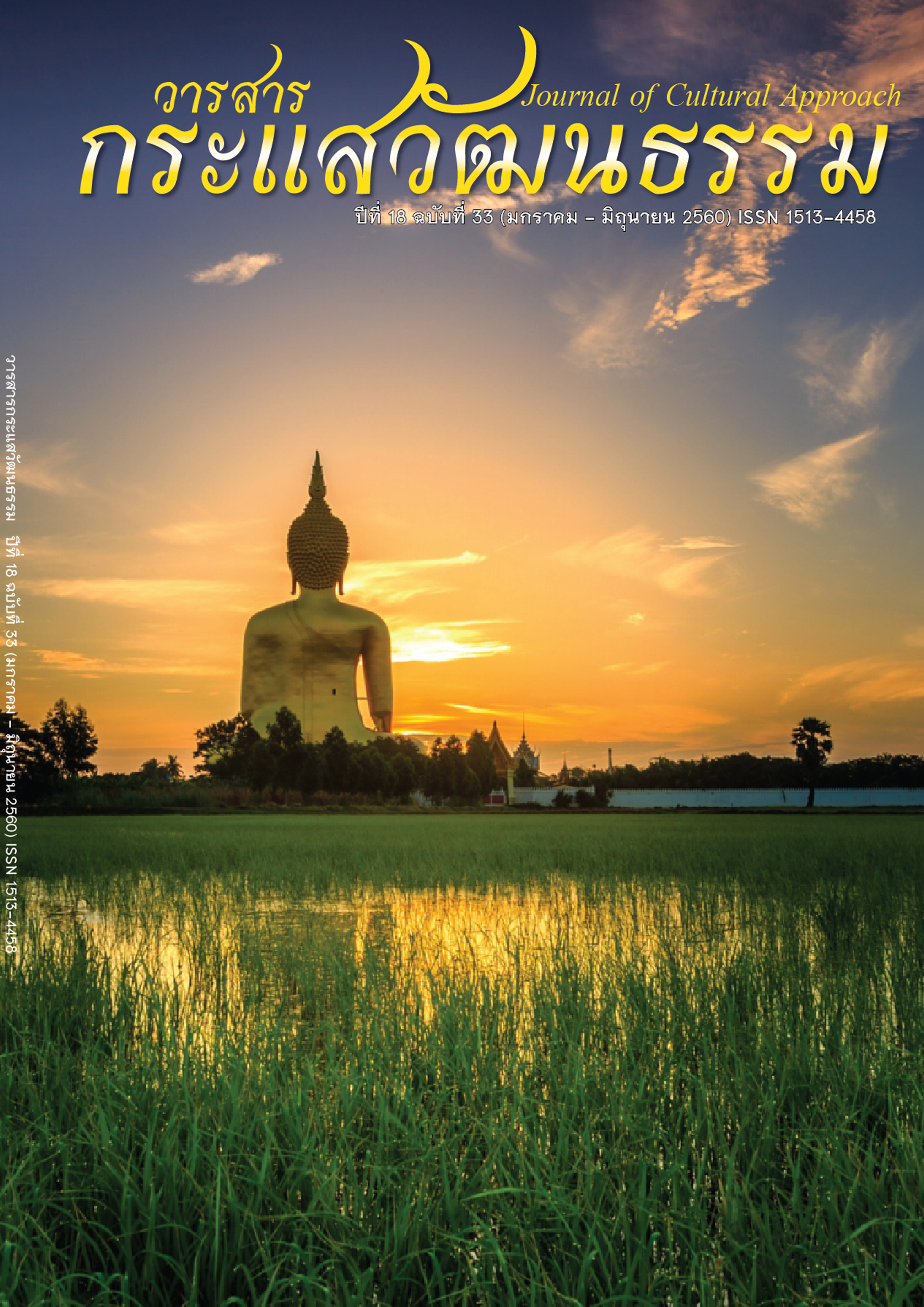แนวทางการพัฒนาส่วนประสมทางการตลาดของที่ระลึกสำหรับนักท่องเที่ยวชาวยุโรปและเอเชียในกรุงเทพมหานคร
Main Article Content
บทคัดย่อ
การศึกษาครั้งนี้มีวัตถุประสงค์เพื่อศึกษาแนวทางการพัฒนาส่วนประสมทางการตลาดของที่ระลึกสำหรับนักท่องเที่ยว เพื่อศึกษาพฤติกรรมการท่องเที่ยวและพฤติกรรมการซื้อของที่ระลึก และเพื่อเปรียบเทียบความคิดเห็นเกี่ยวกับแนวทางการพัฒนาส่วนประสมทางการตลาดของที่ระลึกสำหรับนักท่องเที่ยวชาวยุโรปและเอเชีย โดยกลุ่มตัวอย่างที่ใช้ในการวิจัยเป็นนักท่องเที่ยวชาวยุโรปและเอเชียที่เดินทางมาท่องเที่ยวในกรุงเทพมหานคร จำนวน 400 คน เครื่องมือที่ใช้ในการวิจัยเป็นแบบสอบถาม โดยนำผลที่ได้มาวิเคราะห์ทางสถิติ
ผลการวิจัย
1. ผู้ตอบแบบสอบถามมีความคิดเห็นเกี่ยวกับแนวทางการพัฒนาส่วนประสมทางการตลาดของที่ระลึกสำหรับนักท่องเที่ยวชาวยุโรปและเอเชียส่วนใหญ่เห็นด้วยอยู่ในระดับมาก ได้แก่ ด้านราคา (= 3.73,
= 3.69) ด้านช่องทางและสถานที่จัดจำหน่าย (
= 3.67,
= 3.66) ด้านบุคลากร (
= 3.61,
= 3.50) และด้านผลิตภัณฑ์ (
= 3.57,
= 3.62) ยกเว้นด้านการส่งเสริมการตลาด (
= 3.14,
= 3.36) เห็นด้วยอยู่ในระดับปานกลาง
2. ผู้ตอบแบบสอบถามส่วนใหญ่เดินทางมากรุงเทพมหานครเป็นครั้งแรก มีวัตถุประสงค์ในการเดินทางเพื่อมาท่องเที่ยว/นันทนาการในช่วงวันหยุดพักผ่อนในช่วงฤดูฝน พึงพอใจแหล่งช้อปปิ้งย่านปทุมวัน เดินทางมาซื้อของที่ระลึกกับครอบครัว ค่าใช้จ่ายสำหรับการซื้อของที่ระลึกในครั้งนี้เป็นจำนวนน้อยกว่า 100 US Dollars สำหรับนักท่องเที่ยวชาวยุโรป และ 100 – 150 US Dollars สำหรับนักท่องเที่ยวชาวเอเชีย โดยได้รับข้อมูลข่าวสารมาจากอินเตอร์เน็ต มีการวางแผนจะกลับมาซื้อของที่ระลึกอีกครั้ง และชื่นชอบของที่ระลึกประเภทผ้ามากที่สุดเพื่อนำไปเป็นของฝากเพื่อน
3. นักท่องเที่ยวชาวยุโรปและเอเชียมีความคิดเห็นเกี่ยวกับแนวทางการพัฒนาส่วนประสมทางการตลาดของที่ระลึก ในด้านการส่งเสริมการตลาดแตกต่างกันอย่างมีนัยสำคัญทางสถิติที่ระดับ 0.05
Article Details
Proposed Creative Commons Copyright Notices
1. Proposed Policy for Journals That Offer Open Access
Authors who publish with this journal agree to the following terms:
- Authors retain copyright and grant the journal right of first publication with the work simultaneously licensed under a Creative Commons Attribution License that allows others to share the work with an acknowledgement of the work's authorship and initial publication in this journal.
- Authors are able to enter into separate, additional contractual arrangements for the non-exclusive distribution of the journal's published version of the work (e.g., post it to an institutional repository or publish it in a book), with an acknowledgement of its initial publication in this journal.
- Authors are permitted and encouraged to post their work online (e.g., in institutional repositories or on their website) prior to and during the submission process, as it can lead to productive exchanges, as well as earlier and greater citation of published work (See The Effect of Open Access).
Proposed Policy for Journals That Offer Delayed Open Access
Authors who publish with this journal agree to the following terms:
- Authors retain copyright and grant the journal right of first publication, with the work [SPECIFY PERIOD OF TIME] after publication simultaneously licensed under a Creative Commons Attribution License that allows others to share the work with an acknowledgement of the work's authorship and initial publication in this journal.
- Authors are able to enter into separate, additional contractual arrangements for the non-exclusive distribution of the journal's published version of the work (e.g., post it to an institutional repository or publish it in a book), with an acknowledgement of its initial publication in this journal.
- Authors are permitted and encouraged to post their work online (e.g., in institutional repositories or on their website) prior to and during the submission process, as it can lead to productive exchanges, as well as earlier and greater citation of published work (See The Effect of Open Access).
References
[2] Chimlek, Surangkana. (2002). Guideline for Marketing Development of Jewelry Souvenir Product at Chatuchak Market. Master’s Thesis, Chiang Mai University.
[3] Department of Tourism. (2014). Tourist Statistic. Retrieved January 21, 2015, from http://newdot2. samartmultimedia.com/home/details/11/221/23044.
[4] Gulick, L. (1937). Paper on the Science of Administration. In the Luther Gulick and Lyndall Urwick (eds.), Notes on the Theory of Organization. New York: Institute Of Public Administration.
[5] Jamphut, Orawan. (2006). Guidelines for Marketing Development of OTOP Products toward Tourism Industry in Chiang Rai Province. Journal of International and Thai Tourism, 2, 1-14.
[6] Kotler, P. (2000). Marketing Management. New Jersey: Prentice - Hall.
[7] National News Bureau of Thailand. (2010). Bangkok was voted to be Number One of World’s Best Award 2010. Retrieved January 21, 2015, from http://thai news.prd.go.th/.
[8] Nomura, M. (2002). Souvenir Purchase Patterns of Domestic Tourists Case Study of Taka Yama City, Japan. Master’s Thesis, University of Wisconsin - Stout.
[9] Nunnally, J. C., & Bernstein, I. H. (1994). Psychometric Theory. 3rd ed. New York: McGraw-Hill.
[10] Prideaux, B. (2006). Backpacker Shopping in the Tropics: An Overview of the Shopping Behavior of Backpackers in Cairns. Master’s Thesis, James Cook University.
[11] Punpeng, Pagasit. (2010). Motivations to visit Chatuchak Weekend Market of Foreign Tourists. Master’s Thesis, Chulalongkorn University.
[12] Rovinelli, R. J., & Hambleton, R. K. (1977). On the Use of Content Specialists in the Assessment of Criterion-Referenced Test Item Validity. Dutch Journal of Educational Research, 2, 49-60.
[13] Samerjai, Chattayaphon. & Wareewanich, Thitinan. (2008). Principle of Marketing. Bangkok:
Se-Education.
[14] Schmid, T. (2013). Wholesale Products from Thailand-The Top 10. Retrieved April 10, 2015, from http://www.wholesalelubang.com/.
[15] Solomon, M. R. (1999). Consumer Behavior: Buying, Having and Being. 4th ed. New Jersey: Prentice - Hall.
[16] The Interactive Research. (2010). The Survey of Foreign Tourists’ Behavior and Satisfaction in Shopping and Entertainment Campaign in Thailand. e - TAT Tourism Journal, 4, 1-11.
[17] Yamane, T. (1973). Statistic: An Introductory Analysis. Tokyo: Harper International Edition.

